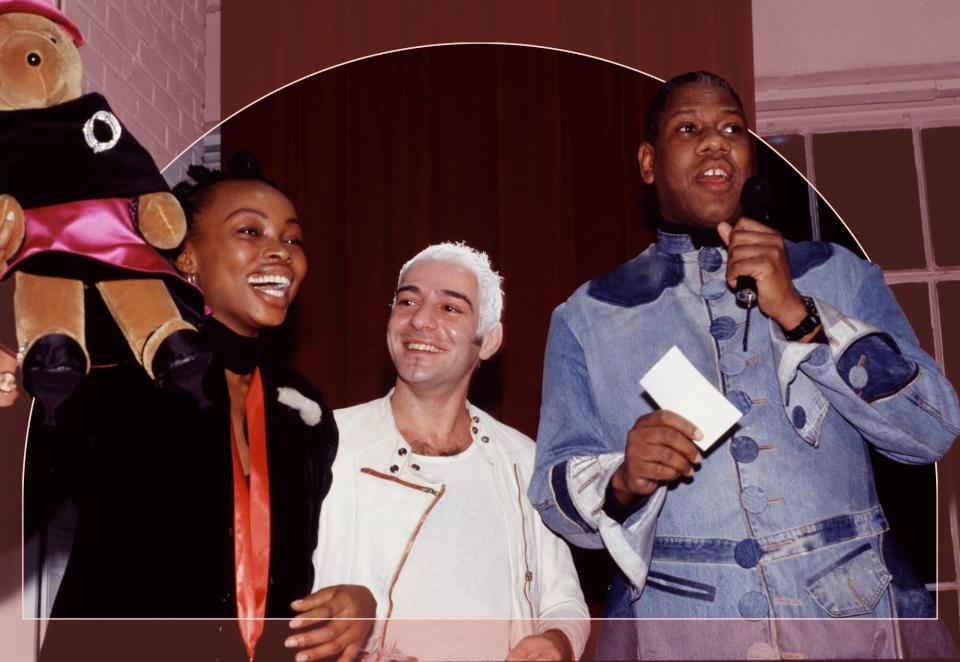Where Would Fashion Be without André Leon Talley?

- Oops!Something went wrong.Please try again later.
Getty Images
Stars, both galactic and human, are born with an inevitability of greatness. André Leon Talley, the former Vogue creative director and fashion legend who passed on Tuesday at the age of 73, was one such star.
"I had to make my own world within my world," he wrote in his 2020 memoir, The Chiffon Trenches, of finding his way as an inquisitive child. The sentiment, so quietly understated, reflects the path he would later carve for himself the notoriously brutal world of fashion. Born in Washington D.C. and raised by his grandmother in the Jim Crow South of Durham, North Carolina, Talley grew up an only child. Unflinching in his pursuit for knowledge, he studied the world around him and dared to see it differently. When he entered the fashion industry, his presence was palpable. There was a Before André — dull, white, stuffy — and an After André — full of humor, grit, beauty, and a much-needed fresh perspective.
Talley's was an almost impossible talent. With his degrees, his fluency in multiple languages, and his charm and wit, he ascended every rung of the proverbial ladder to the coveted position of Vogue creative director in 1988, rubbing shoulders with peers like Jean-Michel Basquiat, Andy Warhol, and Diana Ross along the way. He compelled everyone fortunate enough to find themselves in his orbit to love him back. His tenure at the publication was one of thoughtful curation and a keen eye for what was to come. But Talley understood that fashion was so much more than the differences between Italian and French tailoring or merely predicting the next trend; he knew that people made the work important.

Getty Images
Talley credited his lifelong dedication to elegance to his beloved grandmother, whose style and confidence he adored. His master's thesis, on Black women's influence on Charles Baudelaire, notable French poet and art critic of the 19th century, seems an almost too-on-the-nose prediction of his own career, and how Black women would influence his work in the fashion industry. He devoted his time to the advancement and inclusion of Black designers and models in the fashion world, and recognized his own presence as an anomaly. In 2019, he wrote in the Washington Post, "I quietly worked to bring more of that newness into the room: fashion editorials featuring young Black models Naomi Campbell and Veronica Webb." In his own refined way, Talley defied a centuries-old white vanguard of fashion: "I sounded no bullhorn over diversity but nurtured it where I could."
RELATED: Celebrities React to Death of Former Vogue Editor André Leon Talley
Black, queer, big, and Southern, Talley was an opus of possibility. In the 2018 documentary The Gospel According to André, actress and talk show host Whoopi Goldberg said of Talley, "he was so many things he was not supposed to be." Talley was a creative director, a journalist, an author, a visionary and tastemaker; he took up space in an infamously sterile, unfeeling industry, and showed the world what it could be.

Getty Images
Fashion would not be where it is today were it not for Talley's will. The young Black artists and designers pushing the envelope in fashion currently owe a great debt to Talley — and they know it. Estée Lauder's creative advisor and Pyer Moss' show director, Dario Calmese, said in tribute to Talley, "There is not one Black person in fashion who doesn't owe wherever they are to the sacrifices, generosity, and sheer brilliance of André Leon Talley." Where would the fashion world be without him? It's a question that's almost too brutal to imagine the answer to, but leads us to a different, more urgent question: Where does it go from here? In a 2020 survey, the New York Times asked the 64 largest womenswear brands and 15 major department stores about the percentage of Black employees, as well as Black executives. They also calculated the representation of Black people in their ad campaigns and runway shows. Of the 64 brands surveyed, only one had a Black CEO — Virgil Abloh for Off-White. And of the 69 designers and/or creative directors at the same companies, only four were Black; one of them, again, being Abloh. An already bleak statistic made painfully worse by Abloh's own untimely passing less than two months ago.
In 1994, The New Yorker described Talley as "The Only One" — and it's unsettling to see how apt the moniker remains today. Design is an iterative process, with revision being the only vehicle to success. Talley recognized the power of ruthlessly editing everything, and recognized that all of it — people, art, life — should undergo change; indeed, to make any sort of impact, they require it.
RELATED: Black Designers Are Rarely Featured in Movies — but That's About to Change
Every so often, people become their own kind of supernova. They shine so bright, it can be easy to forget there was ever darkness. Talley was that for so many of us. A collision of history and grace, he created an unrepeatable blueprint. Loss is like that, too. Unrepeatable in its unique grief. But it's a kind of sacred knowing, too. Revealing what we were in the presence of, what we existed alongside, and what we were missing before them; their absence is, to quote Talley, our own "famine of beauty." Talley knew what he wanted his legacy to be, stating, "I scorched the earth with my talent and I let my light shine." And with his passing, we have the creation of our newest supernova, an explosion lighting the way for the next improbable greats.

